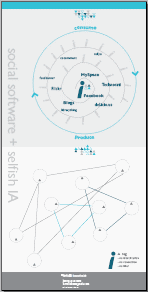IA Summit 2006 poster session presentation
URL of this information: http://12frogs.com/12/work/iasummit2006
PDF of poster
Jenny Spadafora
email: hermitlabs at gmail
blog: http://12frogs.com/12
What the increasing use of social software means
- It's all about me (even when I'm on your site)
- I'm a content consumer and a content producer
- Solutions for managing professionally-created and maintained content don't necessarily make sense for individually-created content
- Tags support content discovery and distribution
- Solving for individual needs can also create value for others
Context
Social software tools are changing how people express what they know and what is known about them. As the adoption rate of social networking sites rises (Facebook's market penetration is at 85% of eligible college students) so will the call for information architecture to solve problems for the individual, rather than for the corporation or institution.
Social websites are "selling" connection, contact, identification, and self-expression -- so architecting the least painful path to a shopping cart isn't an issue. Different user motivations require different architecture, serving the primary needs of:
- Generation and dissemination -- structure information I create or know about (blog posts, flickr photo sets, del.icio.us bookmarks)
- Discovery -- structure infomation I want to know about so that I will find it (feeds, searchrolls, tags)
Solutions for managing professionally-created and maintained content don't necessarily make sense for individually-created content -- so we see an explosion of tagging. When it comes to avoiding information overload, structuring meaning "for me" is paramount, and making that structure socially relevant is secondary. The possibilities for creating "usable exhaust" -- social relevance as byproduct of individually valuable actions -- present an enormous opportunity and challenge for information architecture.
Links for sites in the social software spiral:
Facebook
http://facebook.com
The college crowd online -- 85% of eligible students are using it
MySpace
http://myspace.com
Biggest social networking site -- seeded with LA club kids
Blogs
Wikipedia article on blogs
They number in the tens of millions worldwide
Flickr
http://flickr.com
Photo sharing -- fueled by tagging and networking
Technorati
http://technorati.com
Blog tracker -- self-decribed authority on the blog world
del.icio.us
http://del.icio.us
Social bookmarking -- save, tag, and share URLs
LibraryThing
http://www.librarything.com
Social book cataloging -- mixes classification information and tags
Feedburner
http://www.feedburner.com
Service for feed producers and consumers
coComment
http://cocomment.com
Track your comments left on blogs
Rollyo
http://rollyo.com
Social search -- group and tag URLs to make sharable searchrolls
